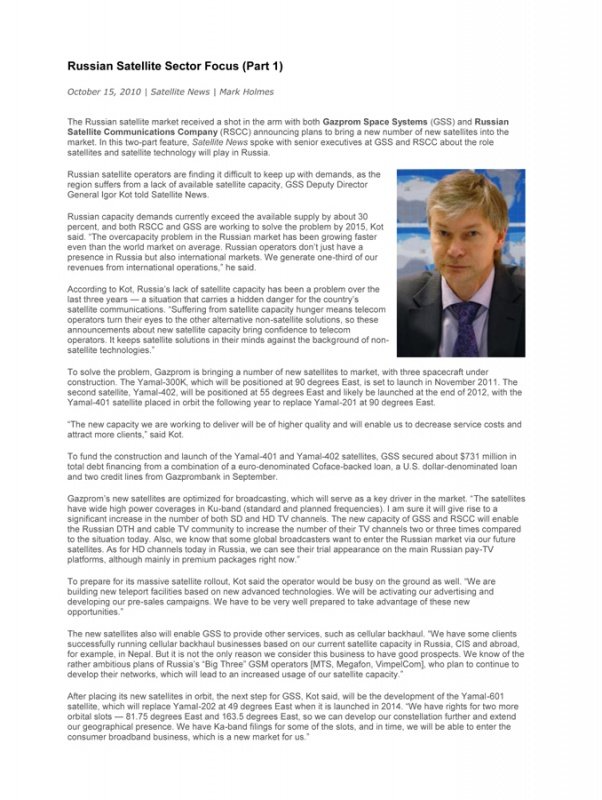Russian Satellite Sector Focus
The Russian satellite market received a shot in the arm with both Gazprom Space Systems (GSS) and Russian Satellite Communications Company (RSCC) announcing plans to bring a new number of new satellites into the market. In this two-part feature, Satellite News spoke with senior executives at GSS and RSCC about the role satellites and satellite technology will play in Russia.
[Satellite News 10-15-10] Russian satellite operators are finding it difficult to keep up with demands, as the region suffers from a lack of available satellite capacity, GSS Deputy Director General Igor Kot told Satellite News.
Russian capacity demands currently exceed the available supply by about 30 percent, and both RSCC and GSS are working to solve the problem by 2015, Kot said. “The overcapacity problem in the Russian market has been growing faster even than the world market on average. Russian operators don’t just have a presence in Russia but also international markets. We generate one-third of our revenues from international operations,” he said.
According to Kot, Russia’s lack of satellite capacity has been a problem over the last three years — a situation that carries a hidden danger for the country’s satellite communications. “Suffering from satellite capacity hunger means telecom operators turn their eyes to the other alternative non-satellite solutions, so these announcements about new satellite capacity bring confidence to telecom operators. It keeps satellite solutions in their minds against the background of non-satellite technologies.”
To solve the problem, Gazprom is bringing a number of new satellites to market, with three spacecraft under construction. The Yamal-300K, which will be positioned at 90 degrees East, is set to launch in November 2011. The second satellite, Yamal-402, will be positioned at 55 degrees East and likely be launched at the end of 2012, with the Yamal-401 satellite placed in orbit the following year to replace Yamal-201 at 90 degrees East.
“The new capacity we are working to deliver will be of higher quality and will enable us to decrease service costs and attract more clients,” said Kot.
To fund the construction and launch of the Yamal-401 and Yamal-402 satellites, GSS secured about $731 million in total debt financing from a combination of a euro-denominated Coface-backed loan, a U.S. dollar-denominated loan and two credit lines from Gazprombank in September.
Gazprom’s new satellites are optimized for broadcasting, which will serve as a key driver in the market. “The satellites have wide high power coverages in Ku-band (standard and planned frequencies). I am sure it will give rise to a significant increase in the number of both SD and HD TV channels. The new capacity of GSS and RSCC will enable the Russian DTH and cable TV community to increase the number of their TV channels two or three times compared to the situation today. Also, we know that some global broadcasters want to enter the Russian market via our future satellites. As for HD channels today in Russia, we can see their trial appearance on the main Russian pay-TV platforms, although mainly in premium packages right now.”
To prepare for its massive satellite rollout, Kot said the operator would be busy on the ground as well. “We are building new teleport facilities based on new advanced technologies. We will be activating our advertising and developing our pre-sales campaigns. We have to be very well prepared to take advantage of these new opportunities.”
The new satellites also will enable GSS to provide other services, such as cellular backhaul. “We have some clients successfully running cellular backhaul businesses based on our current satellite capacity in Russia, CIS and abroad, for example, in Nepal. But it is not the only reason we consider this business to have good prospects. We know of the rather ambitious plans of Russia’s “Big Three” GSM operators [MTS, Megafon, VimpelCom], who plan to continue to develop their networks, which will lead to an increased usage of our satellite capacity.”
After placing its new satellites in orbit, the next step for GSS, Kot said, will be the development of the Yamal-601 satellite, which will replace Yamal-202 at 49 degrees East when it is launched in 2014. “We have rights for two more orbital slots — 81.75 degrees East and 163.5 degrees East, so we can develop our constellation further and extend our geographical presence. We have Ka-band filings for some of the slots, and in time, we will be able to enter the consumer broadband business, which is a new market for us.”
Mark Holmes

